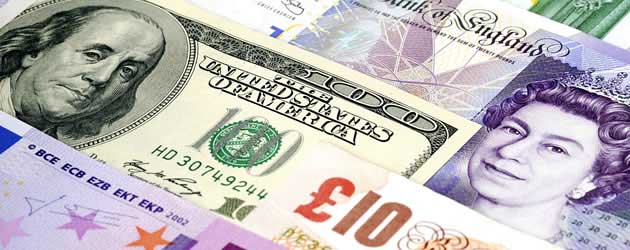
The Pound to US Dollar exchange rate (GBP/USD) fell by around half a cent yesterday in response to the latest FOMC policy statement, which was seen to be less dovish than traders had anticipated. The ‘Greenback’ ran into resistance at 1.6000 and GBP/USD subsequently consolidated around the 1.6040 mark.
The Euro to US Dollar exchange rate (EUR/USD) plunged by around -0.4 cents to 1.3730 in response to the surprisingly sanguine report from the Federal Reserve.
Following the 16-day government shutdown, which postponed vast swathes of economic releases and is thought to have reduced American GDP by -$24 billion, or -0.6%, the majority of market players came to the conclusion that the Fed will not be tapering asset purchases during 2013 – with March 2014 being touted as the most likely date for the first QE3 reduction.
However, the US Central Bank opted not to focus too much on the debt ceiling debacle, suggesting that it does not consider the furlough to be a compelling factor in its monetary policy considerations.
In September the Fed noted that increased market interest rates were posing a negative threat to the economy, but this decidedly dovish comment was omitted in October’s FOMC statement and this was taken to suggest that a slowing down of stimulus could take place before the end of the year.
Despite the US Dollar’s relief rallies in the aftermath of the speech, it is still relatively unlikely that the Fed will opt to cut its $85 billion a month asset purchasing during the next two months.
For one: economic data is still likely to be fairly volatile throughout November, as statisticians look to get back on top of things post-government shutdown.
And secondly: there is nothing to suggest that economic conditions have improved sufficiently since September. Moreover, the most important economic indicators have gotten worse: the ADP Employment Change figure for October printed at 130,000 yesterday – its worst score since April – and the Consumer Price Index also fell to a 6-month low, printing at 1.2% for September.
With all things considered, it is still reasonable to hold March 2014 as the most likely date for the taper. This gives markets more time to soak up the Federal Reserve’s torrential monetary stimulus programme of cheap money and raises the possibility of further risk-on rallies. Under this scenario the US Dollar would be expected to decline vs. both the Pound and the Euro.
In overnight trade the New Zealand Dollar appreciated by around half a cent against Sterling due to further comments from the Reserve Bank of New Zealand suggesting that an in interest rate hike is on the cards during the first half of 2014.
The Australian Dollar also strengthened against the Pound, as an outperforming Building Approvals score – 18.6% compared to forecasts of 1.2% – bolstered sentiment towards the ‘Aussie’.

Comments are closed.